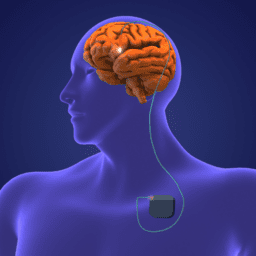As Parkinson’s symptoms progress, increasing medications to address them can bring significant side effects, such as dyskinesia. Surgical therapies can be explored after medications are optimized and the side effects of adding more medications start to outweigh the benefits the medications provide. Current surgical therapies include deep brain stimulation (DBS) and enteral suspension of carbidopa/levodopa. In this post, we’ll take a close look at the latter (for more on DBS, be sure to check out our many resources here), including how carbidopa/levodopa enteral suspension can help you live well with Parkinson’s if you begin experiencing persistent ON/OFF fluctuations.
ENTERAL SUSPENSION MEDICATION DELIVERY: THE CARBIDOPA/LEVODOPA PUMP
Carbidopa/levodopa enteral suspension (branded under the name Duopa™ in the US and known as Duodopa outside of the US) is a Parkinson’s medication delivery system for people experiencing persistent ON/OFF fluctuations, especially those with advanced Parkinson’s. A carbidopa/levodopa gel suspension is delivered through a surgically implanted tube directly into the small intestine, where the medication is absorbed. This medication delivery directly into the small intestine has the added benefit of bypassing the stomach, the emptying of which can become unpredictable or delayed for people with Parkinson’s. The small pump, which you carry or wear, allows infusion of a constant medication dose over 16 hours each day, with your physician’s ability to prescribe additional doses at certain times.
Research shows that carbidopa/levodopa enteral suspension reduces OFF time and increases ON time by almost two hours a day compared to carbidopa/levodopa pills. This effect was especially noted after four weeks of therapy and persisted over 12 weeks in a study of 71 people with Parkinson’s.
Effective therapy in Parkinson’s requires learning about all the potential alternatives, weighing each potential risk and benefit, and then choosing the best one for you. In early Parkinson’s, the response to medications is robust and can be dramatic. However, as Parkinson’s progresses, the therapeutic window (the difference between medication levels in the brain that are too little or too much) diminishes, making it challenging to maintain the correct dose.
-Dr. Martin J. McKeown
Carbidopa/levodopa enteral suspension can improve motor fluctuations by delivering continuous doses of carbidopa/levodopa. Dyskinesia can still occur, although it may be reduced in many cases as medication delivery levels out. The total daily dose of carbidopa/ levodopa needed using carbidopa/levodopa enteral suspension may be less than that for pills.
POTENTIAL RISKS OF ENTERALLY ADMINISTERED CARBIDOPA/LEVODOPA
Like all therapies, there are potential downsides to enterally administered carbidopa/levodopa. The majority of these are seen within the first two weeks following the surgical procedure. The tube may become clogged or kinked, and there may be an infection around the insertion site. Once the tube is in place and the insertion site is suitably healed (typically after a couple of weeks), a careful titration process ensures that the medication levels are just right for you. This procedure varies but typically relies on frequent (at least hourly) observations by trained personnel to ensure that the medication infusion rate is optimal. This sometimes requires staying overnight in the hospital or near a hospital for a couple of days.”
Once the tube has been inserted, your providers are sure there are no complications, and the correct dosing of medication has been achieved, side effects may emerge, like what many people experience when taking the pill form of carbidopa/levodopa: upset stomach, dyskinesia, or dizziness upon standing.
However, a couple of issues appear more commonly with enterally administered carbidopa/levodopa: decreased weight and increased risk of peripheral neuropathy. The reasons for the weight loss are unclear. Often people with severe, disabling dyskinesia can lose weight because of their continual movements. Once the dyskinesia is reduced with enterally administered carbidopa/levodopa, they may regain some weight back. However, some people continue to lose weight for unknown reasons. Peripheral neuropathy, often also seen with the pill form of carbidopa/levodopa, may result from vitamin deficiencies, which you can prevent with oral supplementation as advised by your physician.
WHO SHOULDN’T BE CONSIDERED FOR ENTERALLY ADMINISTERED CARBIDOPA/LEVODOPA THERAPY?
People with mild Parkinson’s symptoms who respond well to oral medication don’t need to proceed with enterally administered carbidopa/levodopa. Additionally, anyone who is unmotivated, non-compliant, or has poor care partner support may have difficulty managing the logistics of storage, delivery of the cassettes, and the pump’s operation. Finally, the medication is expensive, and health insurance coverage may be an issue.
While not a solution for everyone, enterally administered carbidopa/levodopa can be transformative for someone who experiences frustrating ON/OFF fluctuations but is not a candidate for DBS. People who have suffered from severe motor fluctuations may find this therapy allows them to maintain independence and substantially improve their quality of life. Therefore, enterally administered carbidopa/levodopa is an excellent option for advanced Parkinson’s.
This post was written in part by Martin J. McKeown, BEng, MD, FRCP(C), the PPRI/UBC Chair in Parkinson’s Research, Director of the Pacific Parkinson’s Research Centre, and Full Professor in the Department of Medicine and Electrical and Computer Engineering (adjunct) at the University of British Columbia, Canada.
learn more
The Benefits of Duopa™ for people with Parkinson’s

















